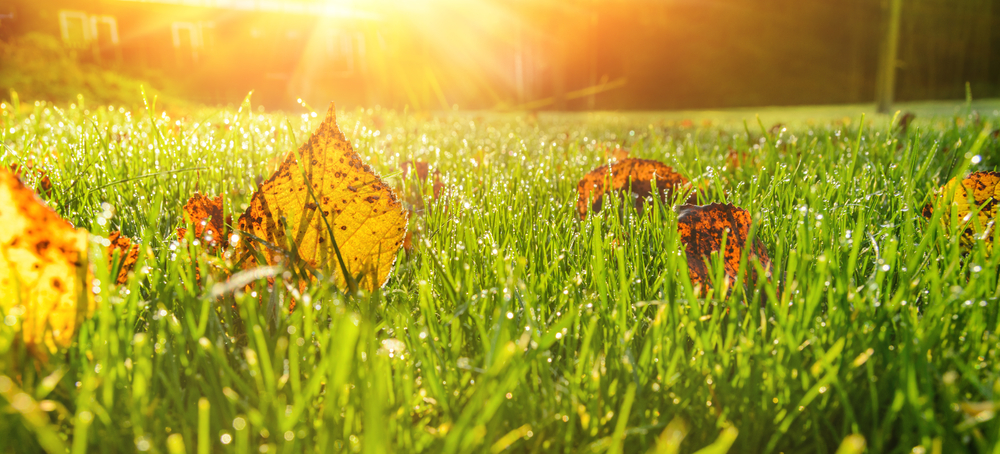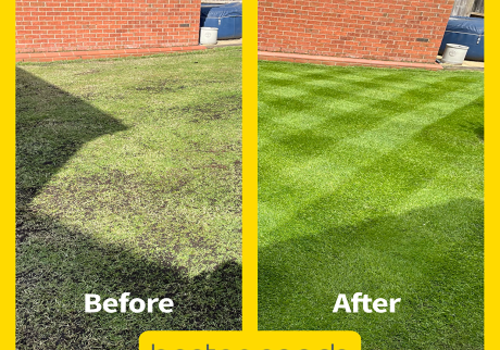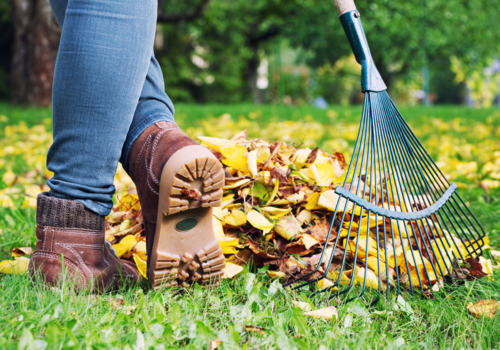
In this blog, we cover all of our top September lawn care tips for the summer and autumn season.
September is a prime month in your lawn care schedule. As the heat of July and August starts to fade, it’s time to prepare for autumn and winter while still keeping on top of growth, just like you have over summer. This month, keep your mower handy, but get ready to roll up your sleeves for tasks that will nourish your grass from root to tip.
What Should I Do to My Lawn in September?
Here’s your September lawn care ‘to-do’ list:
- Regular mowing
- Autumn fertiliser application
- Aerate compact areas
- Scarify if needed
- Final weed control
- Moss control
- Lawn seeding and renovation
Mowing in September
You’ll still need to cut the grass regularly this month to keep on top of growth. Expect to mow around once a week, though growth may slow as October approaches - at that point, mowing every couple of weeks should be enough. As growth slows, raise your mower blades to promote a healthier autumn lawn.
If you have a moss problem, make sure your grass always remains at least 1 inch higher than the moss. This helps the grass stay dominant.
From September onwards, give your mower a thorough clean every time you mow. Aim to cut the grass in the afternoon as this is usually the driest part of the day, which helps prevent too many damp clippings from building up inside your mower and makes post-mow clean-up a lot easier.
Should I Fertilise My Lawn in September?
Yes! September is a great time to fertilise your lawn. The right lawn treatment will help it recover from summer wear and tear and prepare it for the harsh conditions of winter. Choose an autumn and winter lawn fertiliser to strengthen your grass for the months ahead.
Avoid applying fertiliser to dry soil — wait for a decent rainfall first. This is more effective than manually watering, which could wash the fertiliser away. Also, make sure you’ve finished raking and scarifying before applying any lawn treatment.
Can I Scarify My Lawn in September?
Yes, September is an ideal time to scarify your lawn. That said, it’s a fairly intense treatment, so only scarify if your lawn really needs it. If you’ve been keeping up with maintenance throughout the year, you might not need to scarify at all.
How Do I Know If I Need to Scarify?
Check for thatch, a layer of dead turf and organic matter that builds up when grass grows faster than it breaks down. Lawns with too much thatch feel spongy underfoot and show thick, brown debris. More than an inch of thatch can trap moisture, invite pests, and cause disease.
If this sounds like your lawn, use a rake or lawn scarifier to remove moss and thatch. This may leave your lawn looking a little bare, but follow up with fertiliser, top dressing, and overseeding to complete the treatment and bring your grass back to life.
Lawn Renovation
After the long summer months, it’s important to repair and renovate your lawn before winter sets in. Here’s our lawn care advice to help replenish your turf and keep it strong and green into next year:
Aerating
Summer activity can leave lawns compacted, which hinders drainage and root development. Use a garden fork to sink holes around 12–15cm deep, this helps nutrients and water circulate better for stronger, healthier roots.
Trimming
Tidy things up by trimming lawn edges. Use a spade for straight lines and lawn scissors for awkward areas.
Flattening
Uneven ground can cause drought or flooding issues in winter. Now is the time to fix those lumps and bumps. Use a spade to level the area, then aerate and add turf or grass seed as needed.
Seeding
September’s soil temperature and moisture levels are ideal for overseeding. If you haven’t already, sow winter-hardy grass seed to patch up damaged or bare areas. Do this after rainfall and an application of pre-seed fertiliser.
Top Dressing
This advanced lawn care step helps improve soil structure, reduce thatch, smooth uneven surfaces, and encourage root growth. Apply top dressing after you’ve finished your other renovation tasks.
Keep Off the Grass
Once repairs are done, minimise foot traffic. Use paths or stepping stones where possible. If you don’t have a defined route through your garden, now’s a good time to consider creating one.
Moss Control
Moss loves the cooler, wetter weather — so now’s the time to plan ahead. If necessary, scarify to remove moss. You can also apply a moss killer to get ahead of any issues that might develop in early spring.
Laying New Lawns in September
This is an ideal time of year for laying new turf or sowing grass seed. The combination of temperature and moisture supports strong germination and growth.
If you’re seeding, do it after mowing, scarifying, and feeding — and ideally after a rainfall to ensure moist soil. Grass seed typically germinates in 5–10 days, so you’ll see results fast.
Autumn Lawn Care Tips
Weeds
Get on top of any remaining weeds before October. Use a lawn weed killer, or if you’ve kept things under control, manual removal or spot treatments might be enough to see you through to winter.
Pests
Pests like ants, worms, moles, and leatherjackets may make a comeback this month.
- Worm casts, mole hills, and ant hills: Brush them back into the lawn to keep the surface even.
- Leatherjackets (grubs that feed on grass roots): Most gardens have a few without issue, but a major infestation can cause damage. Treatment can be tricky — try a lawn pest killer, but often the best route is to let nature take its course, then scarify, aerate, and overseed to recover once the problem eases.
Toadstools
These may appear as rainfall increases and soil moisture rises. They’re usually harmless and tend to disappear on their own.
Disease
September is when issues like dry patch and fairy rings become more noticeable.
- Dry patches: Caused by water-repellent soil. Treat by spiking and regular watering.
- Fairy rings: These fungal problems leave rings of dry, brown grass. You’ll need to treat and control the fungus to prevent it from spreading.
As September is such a key month for lawn renovation, putting in the effort now will pay off big time — with lush, resilient grass ready to shine through October, November, and December.
Be sure to follow our lawn care diary for expert tips to keep your garden looking its best throughout the changing seasons.
More Lawn Care Help
For guidance throughout the year, check out our monthly lawn calendar — packed with advice for spring, summer, autumn, and winter care. Looking ahead? Don't miss our upcoming lawn care guides:
How We Can Help!
At Boston Seeds, we take pride in our excellent customer service. If you're growing a lawn from scratch and aren’t sure how much grass seed you need, try our handy Grass Seed Calculator — it’ll do the maths in just a few clicks!
Need seed quickly? We offer Next Day Delivery on hundreds of products.
Ordering regularly or in large quantities? Click here to apply for a trade account - we’ll review your application within one working day. Got any questions? Please get in touch, we’re happy to help!


